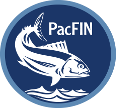FAQS about PacFIN Data
Data in PacFIN is updated based on when we receive datafeeds from our data providers. Data can be updated on a daily, weekly, monthly, quarterly or annual basis. The date at the top of each report tells you when that report was last generated. However, data can be updated at anytime if the data providers deem it necessary. Listed below are common frequencies for datafeeds.
| In-season, At-Sea Whiting | Daily – May to November |
| Permit data from NOAA | Weekly |
| Quota Species Monitoring data | Weekly – Total fleet report Monthly – Limited entry and open access report |
| Fish Ticket Data | Monthly – around the 15th of the month (WDFW, CDFW), and the 30th (CDFW)
Weekly – ODFW |
| U.S. Coast Guard vessel data | Monthly |
| Biological Data Samples (BDS) | Annually – or more frequently |
| Trawl Logbooks | Monthly – WDFW Annually – ODFW, CDFW |
| ADFG/AKR Data | Infrequently |
A round weight of 0.0 metric tons (mt) indicates that some fish were landed in that strata, but less than 0.1 mt were landed. For revenue, a zero indicates that the dealer did not pay for those fish (likely a discard). This will also result in a price per pound of zero.
A dash in a report indicates either an absence of reported data for that strata, or that information was removed due to confidentiality. When data is removed for confidentiality reasons, the column labeled “Confidential” is marked with an asterisk.
The nom. abbreviation is used when a landing or landing(s) of groundfish does not have species composition data applied. When fish are landed at a port, biologists sample the largest percentage of the groundfish landings as they can. This data is used to break out the composition of the landed fish. Market categories, what the buyers purchase, of groundfish are either true species or an aggregation of several similar species that fetch the same market value. Sorting to true species might be mandated by regulation, but is also often driven by the market for a specific fish.
The data reported on fish tickets is always considered nominal. So when a dealer may reports that they bought Nom. Canary Rockfish (CNR1), there is a reasonable chance there is at least a bit of contamination from other species in that market category. Species composition samples are collected at various strata that are generally composed of gear, period, port, and area. These samples are used to assign a percentage of the fish observed that were actually the reported market category. So in this example, lets say on average 99% of the sampled Nom. Canary Rockfish in this strata end up being Canary Rockfish (CNRY) and 1% ends up being Pacific Ocean Perch (POP1). Those proportionsare then applied to all the landings in that strata to arrive at a best estimate of the landed weight for each observed species. For the composite market categories the composition sampling helps split out the multiple species that make up that category.
A groundfish market category is reported as nominal when there are no samples in a given strata to determine the best estimate of the true landing composition. In this scenario the state sampling programs may apply rules to attempt to borrow data from similar gear or nearby ports, but it is not always possible to give an estimate of the sample composition. In most situations a users will want to use a sum of the nominal and actual species (say CNR1 + CNRY) to arrive at the best estimate of the total landings for that species. This can be a little complicated for composite market categories, so please contact PacFIN staff to help address these issues.
The following is a standard method of citing data obtained from the PacFIN system, but the format may vary based on the journal or publication requirements:
“Pacific Fisheries Information Network (PacFIN) retrieval dated _______,
Pacific States Marine Fisheries Commission, Portland, Oregon (www.psmfc.org).”
Information on the retrieval method and/or assistance from PacFIN staff should be put in the methods section, so that others could repeat the process if necessary.
FAQs about fields in comprenhesive_ft table
Details of fields in the compehensive_ft table are coming soon.
